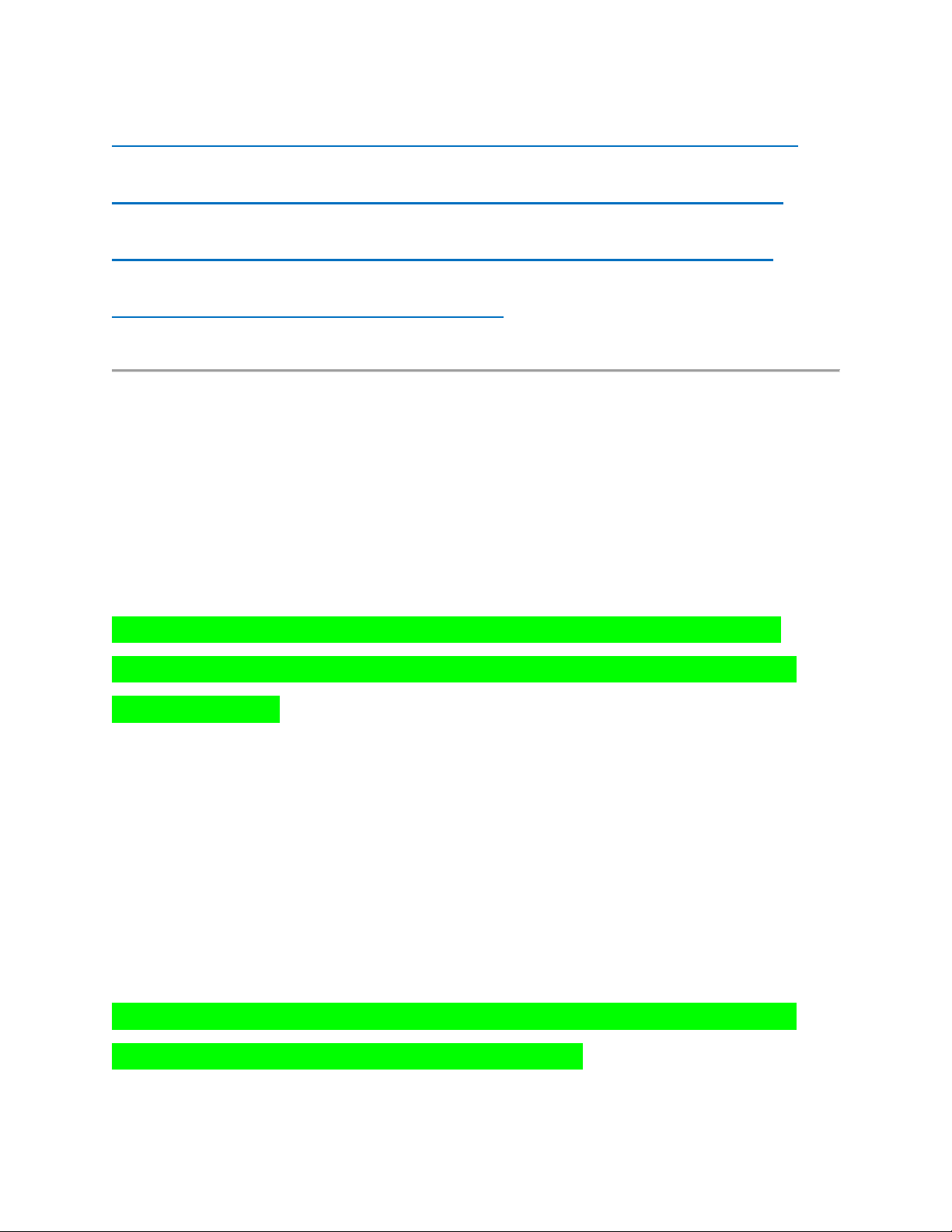
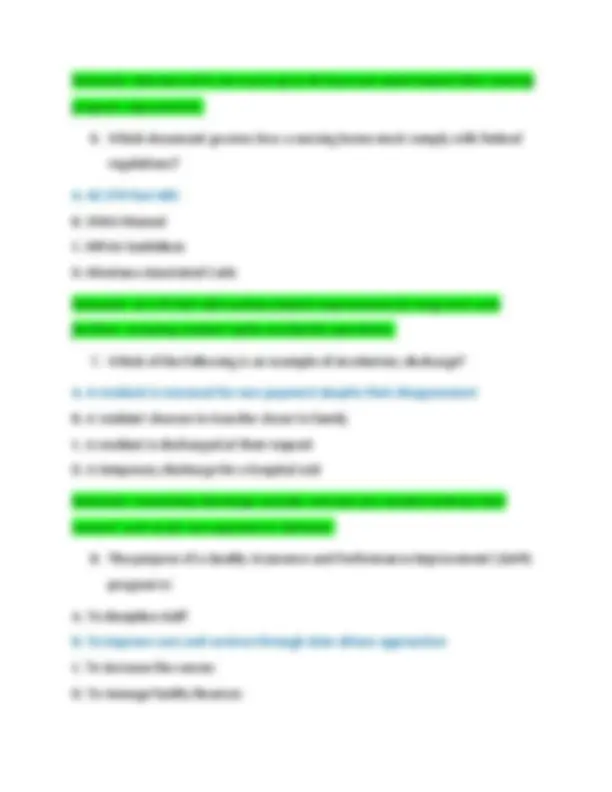
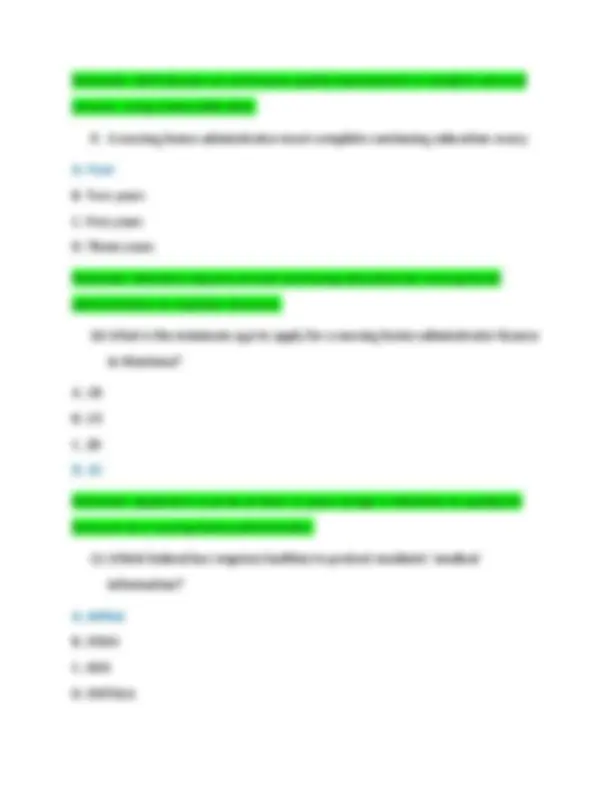
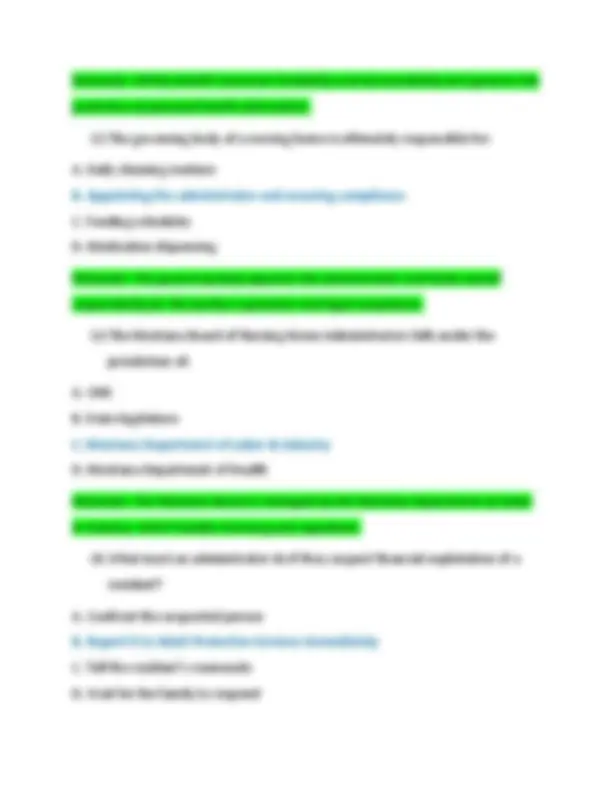
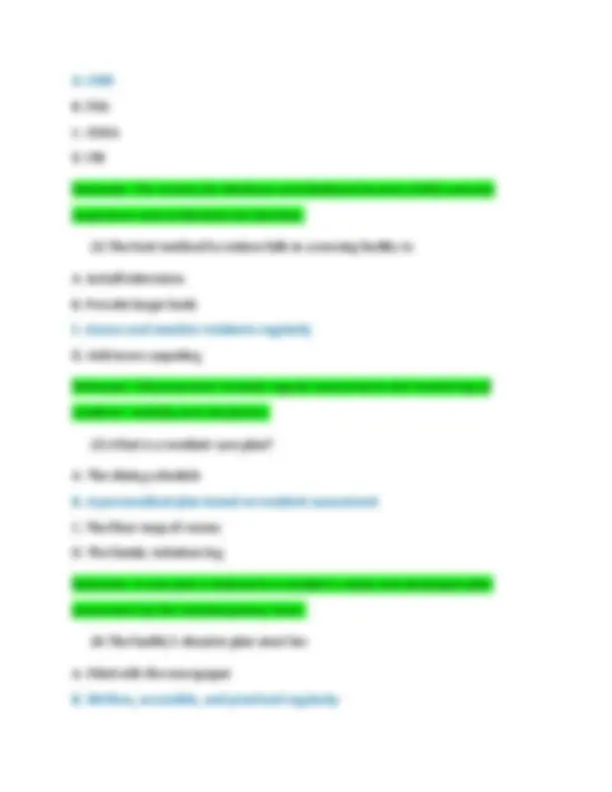
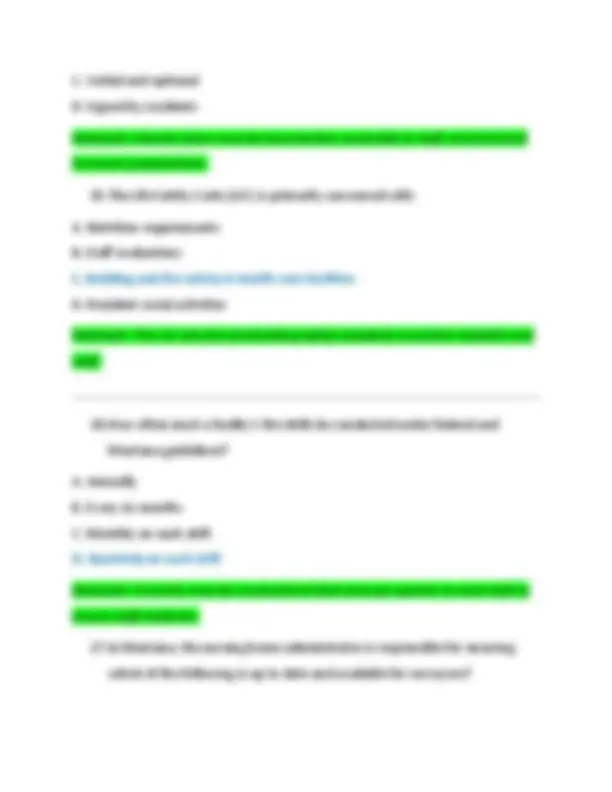
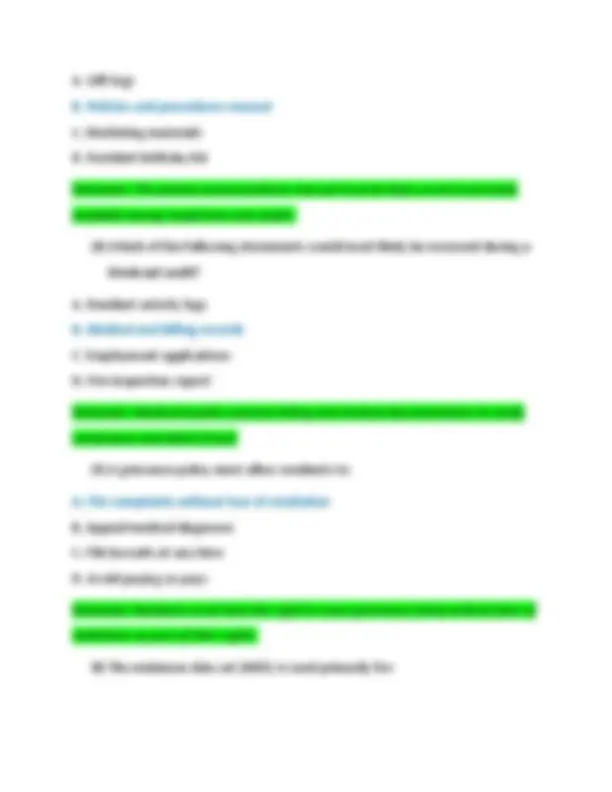
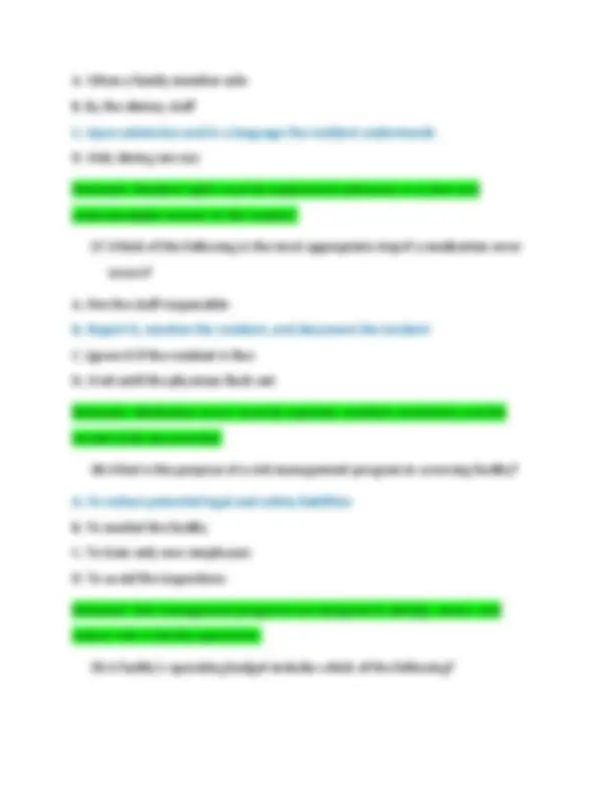
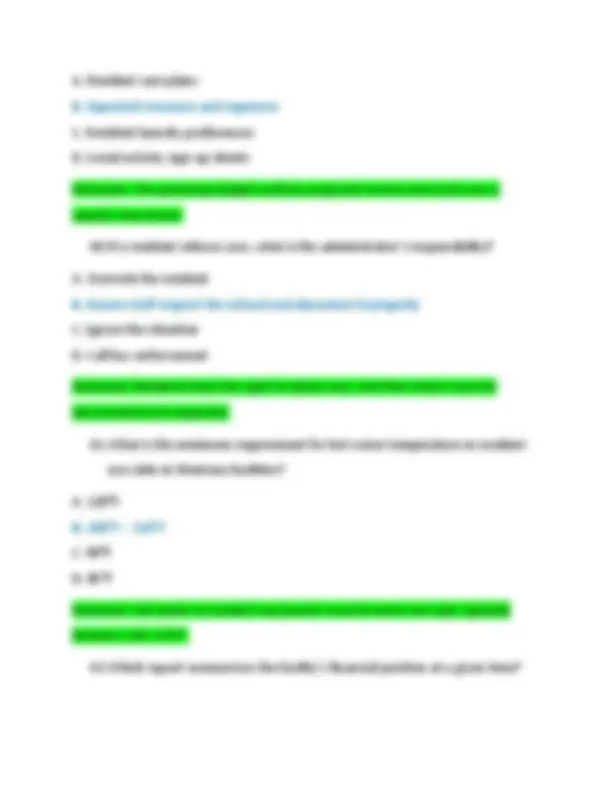
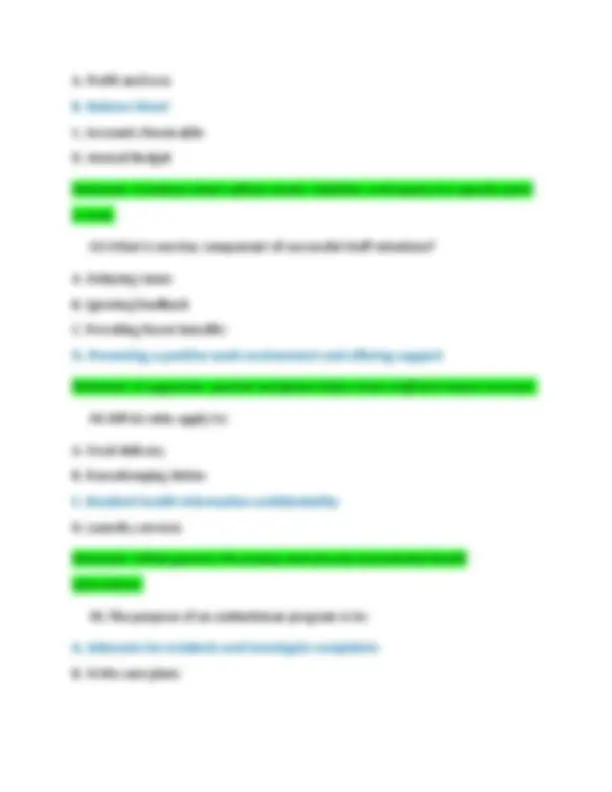

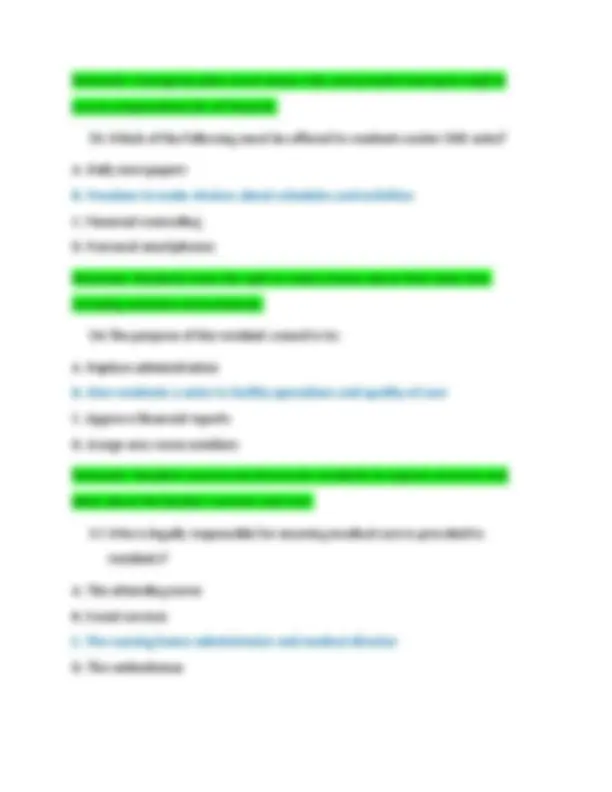
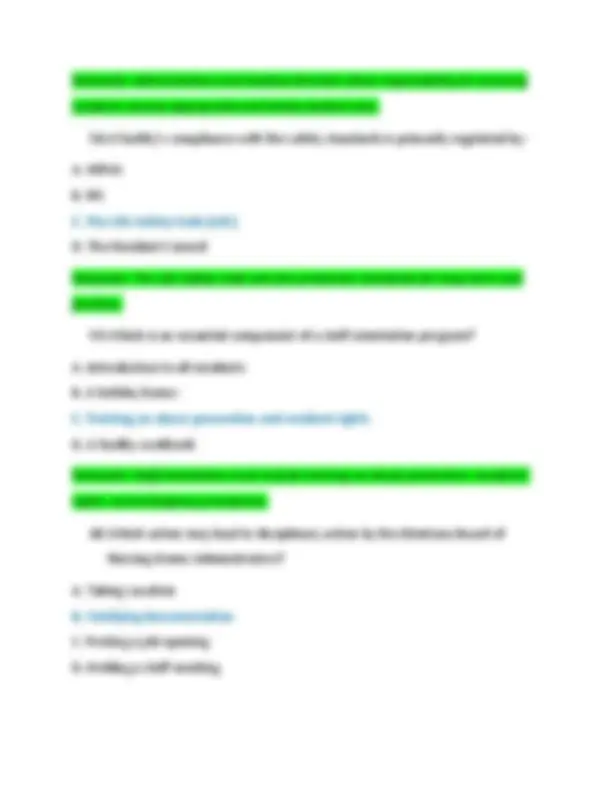
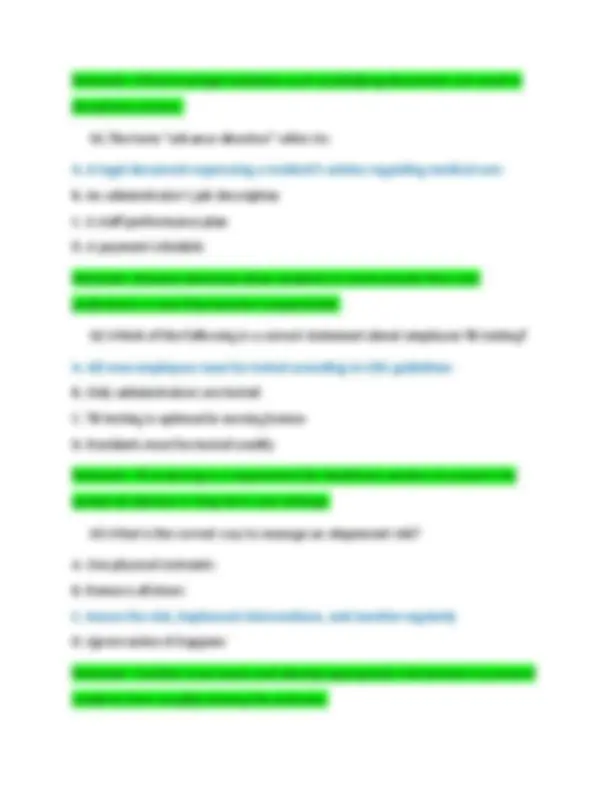
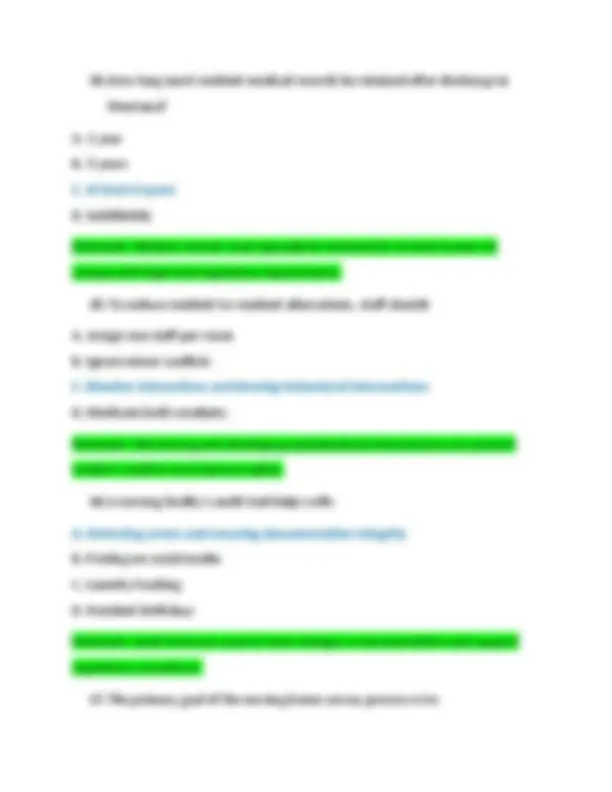
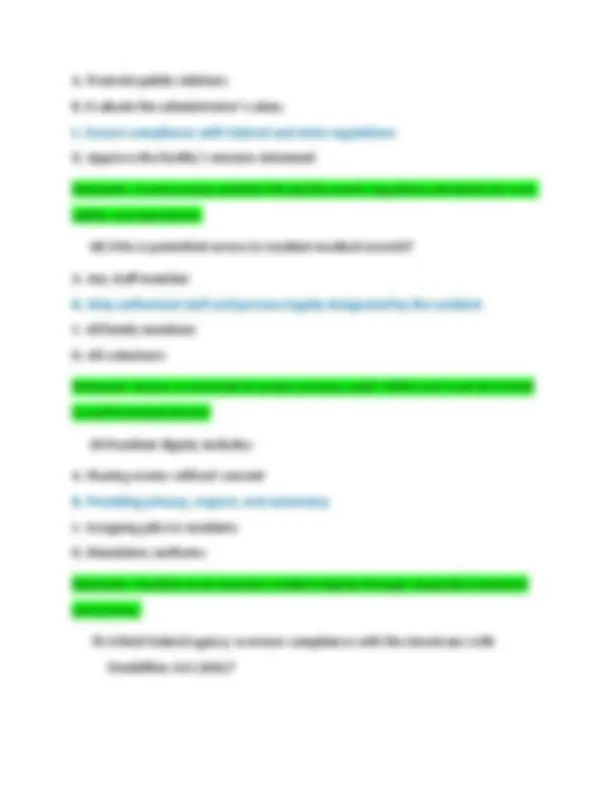
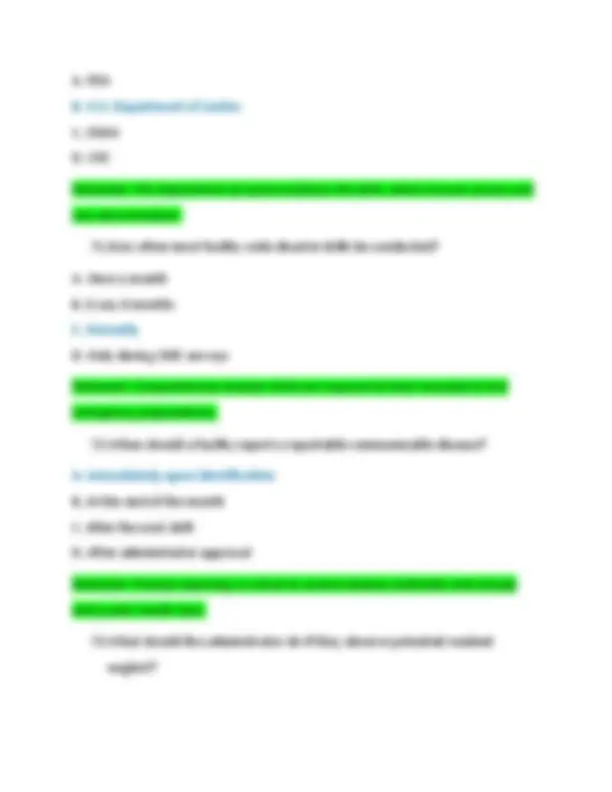
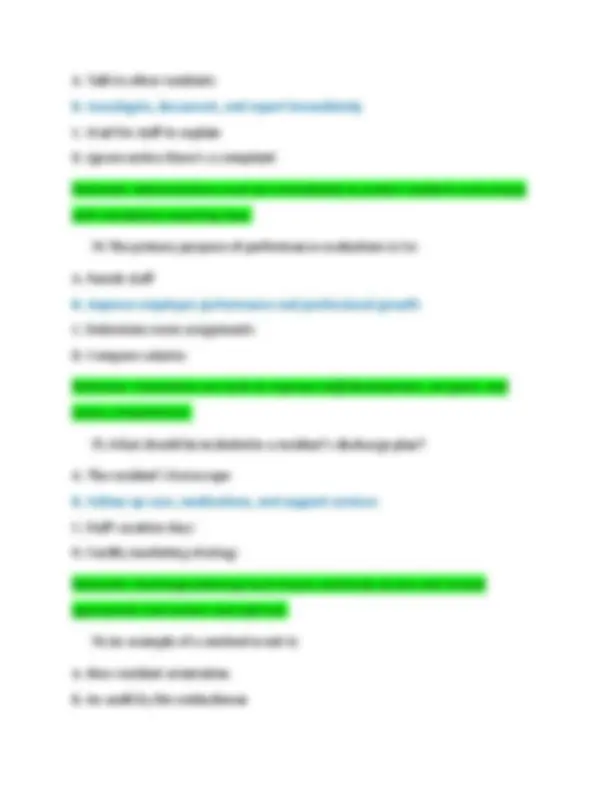
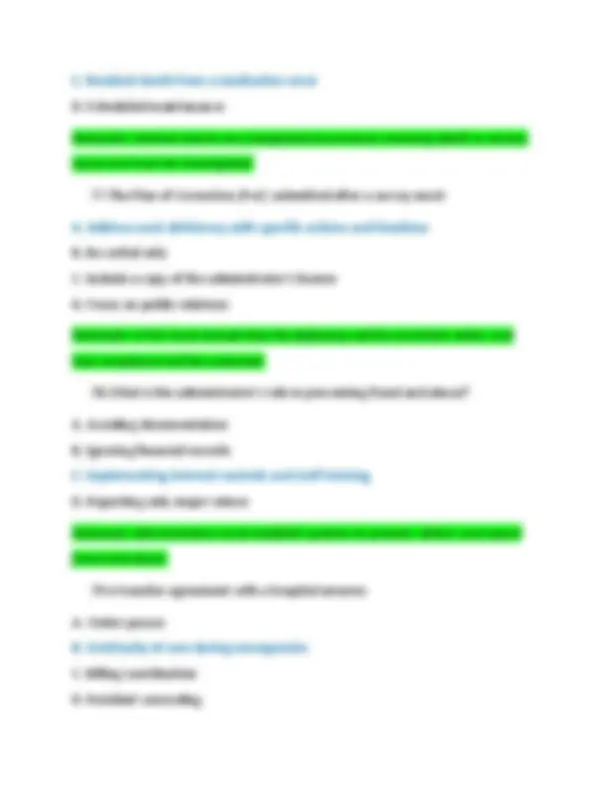
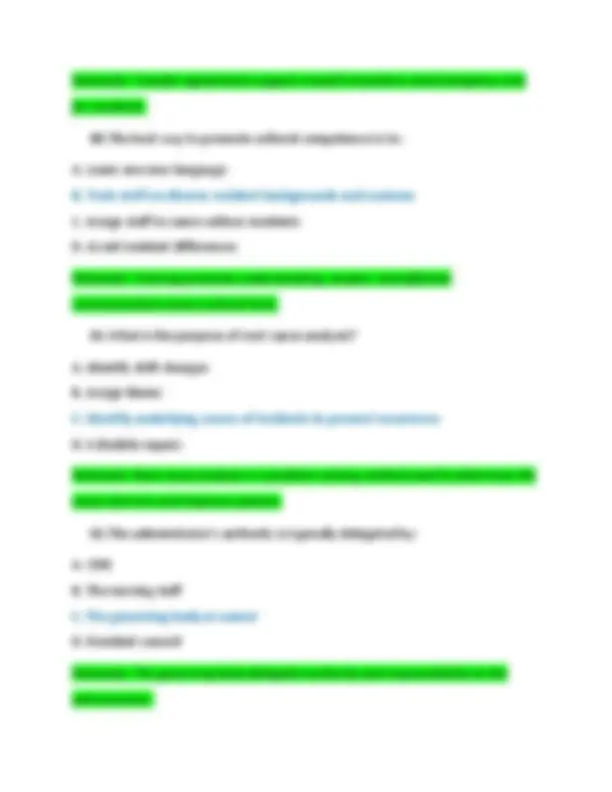
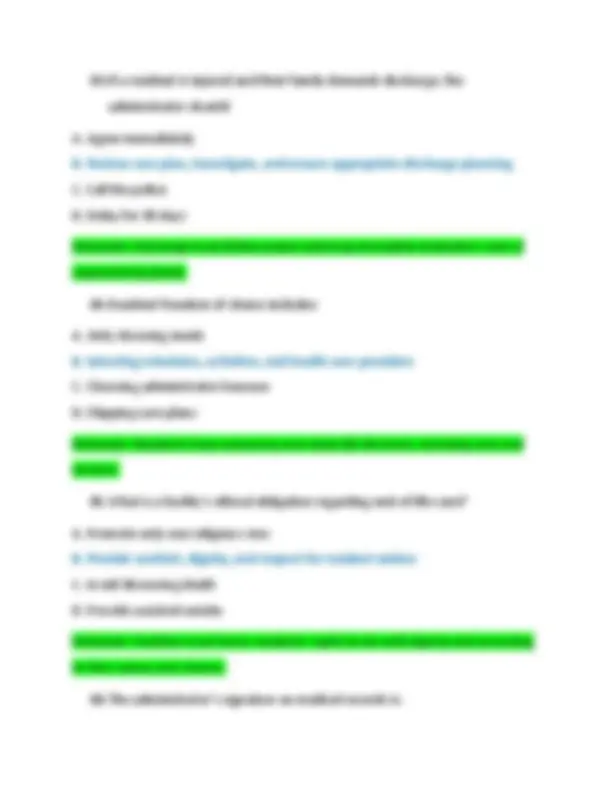
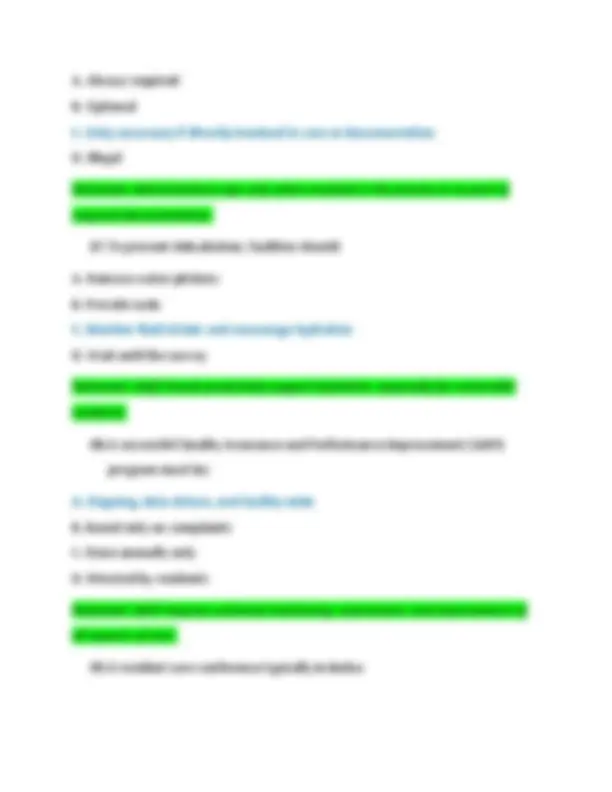
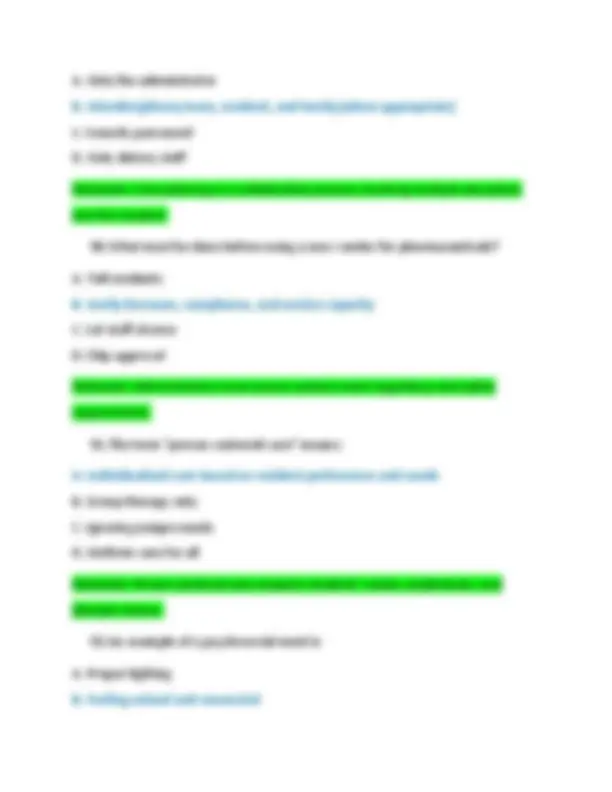
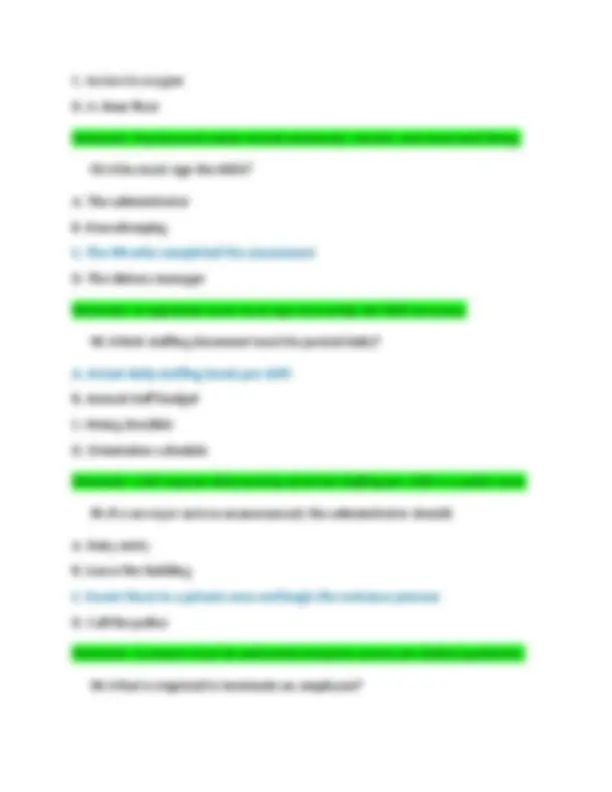
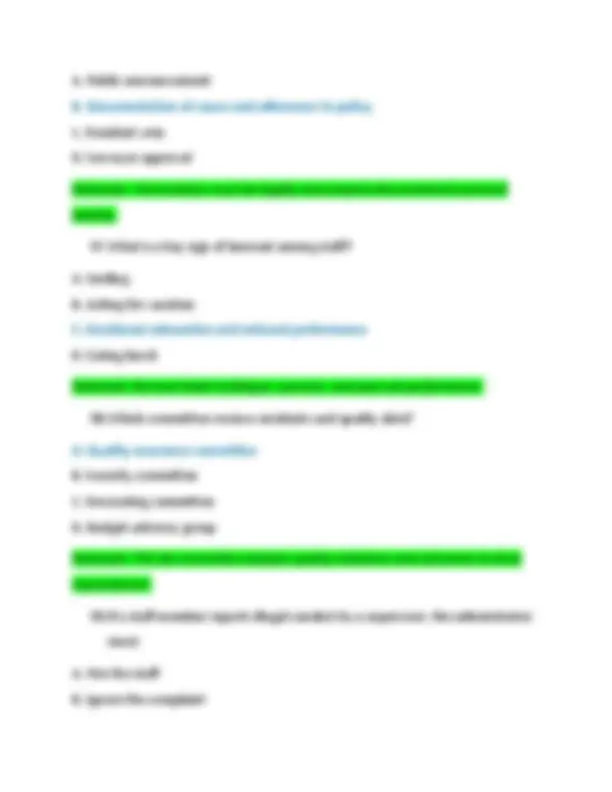
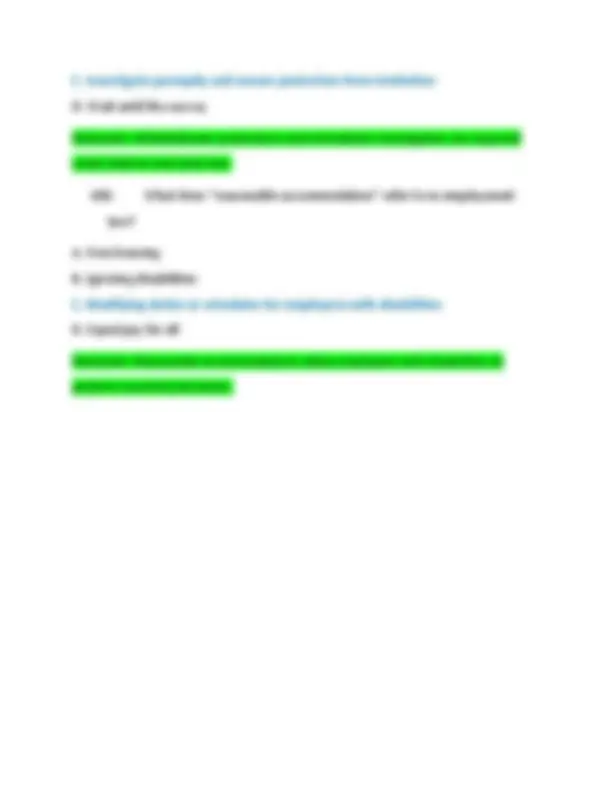


Study with the several resources on Docsity

Earn points by helping other students or get them with a premium plan


Prepare for your exams
Study with the several resources on Docsity

Earn points to download
Earn points by helping other students or get them with a premium plan
Community
Ask the community for help and clear up your study doubts
Discover the best universities in your country according to Docsity users
Free resources
Download our free guides on studying techniques, anxiety management strategies, and thesis advice from Docsity tutors
Montana Dept. of Labor & Industry, Board of Nursing Home Administrators licensing exam Questions And Correct Answers (Verified Answers) Plus Rationales 2025 Q&A | Instant Download
Typology: Exams
1 / 33

This page cannot be seen from the preview
Don't miss anything!


























Rationale: QAPI focuses on continuous quality improvement in resident care and services, using measurable data.
Rationale: HIPAA (Health Insurance Portability and Accountability Act) governs the protection of personal health information. 12.The governing body of a nursing home is ultimately responsible for: A. Daily cleaning routines B. Appointing the administrator and ensuring compliance C. Feeding schedules D. Medication dispensing Rationale: The governing body appoints the administrator and holds overall responsibility for the facility’s operation and legal compliance. 13.The Montana Board of Nursing Home Administrators falls under the jurisdiction of: A. CMS B. State legislature C. Montana Department of Labor & Industry D. Montana Department of Health Rationale: The Montana Board is managed by the Montana Department of Labor & Industry, which handles licensing and regulation. 14.What must an administrator do if they suspect financial exploitation of a resident? A. Confront the suspected person B. Report it to Adult Protective Services immediately C. Tell the resident’s roommate D. Wait for the family to respond
18.Who sets the minimum staffing requirements for nursing homes? A. The administrator B. The residents C. Federal and state regulations D. The medical director Rationale: Staffing standards are established by both federal and state laws, not by individual administrators. 19.The Plan of Correction (PoC) must be submitted after: A. A survey with no deficiencies B. A survey that identifies deficiencies C. A change in staff D. A new resident admission Rationale: A Plan of Correction is required when a survey finds regulatory deficiencies. 20.Which financial report best reflects the facility’s profitability? A. Balance Sheet B. Accounts Payable Ledger C. Income Statement D. Cash Flow Projection Rationale: The income statement (also called profit and loss statement) shows revenues and expenses, reflecting profitability. 21.What federal program inspects facilities for compliance with Medicare and Medicaid?
Rationale: The Centers for Medicare and Medicaid Services (CMS) oversees inspections and certification for facilities. 22.The best method to reduce falls in a nursing facility is: A. Install televisions B. Provide larger beds C. Assess and monitor residents regularly D. Add more carpeting Rationale: Fall prevention includes regular assessments and monitoring of residents’ mobility and risk factors. 23.What is a resident care plan? A. The dining schedule B. A personalized plan based on resident assessment C. The floor map of rooms D. The family visitation log Rationale: A care plan is tailored to a resident’s needs and developed after assessment by the interdisciplinary team. 24.The facility’s disaster plan must be: A. Filed with the newspaper B. Written, accessible, and practiced regularly
A. Gift logs B. Policies and procedures manual C. Marketing materials D. Resident birthday list Rationale: The policies and procedures manual must be kept current and made available during inspections and audits. 28.Which of the following documents would most likely be reviewed during a Medicaid audit? A. Resident activity logs B. Medical and billing records C. Employment applications D. Fire inspection report Rationale: Medicaid audits examine billing and medical documentation to verify compliance and detect fraud. 29.A grievance policy must allow residents to: A. File complaints without fear of retaliation B. Appeal medical diagnoses C. File lawsuits at any time D. Avoid paying co-pays Rationale: Residents must have the right to voice grievances freely without fear of retaliation as part of their rights. 30.The minimum data set (MDS) is used primarily for:
A. Recording daily meals B. Assessing residents and guiding care planning C. Legal documentation D. Scheduling laundry services Rationale: The MDS is a standardized assessment tool used to evaluate resident needs and help develop care plans. 31.The Infection Prevention and Control Program (IPCP) must include: A. Pet care schedules B. Surveillance, reporting, and staff education C. Resident game nights D. Dietary preferences Rationale: An effective IPCP includes monitoring infections, reporting procedures, and staff training. 32.Which of the following best describes the role of the facility’s medical director? A. Conduct staff interviews B. Coordinate medical care policies and oversee physician services C. Balance the budget D. Inspect the physical plant Rationale: The medical director provides oversight of medical care and helps establish clinical care policies. 33.A resident with dementia who wanders needs which type of intervention?
A. When a family member asks B. By the dietary staff C. Upon admission and in a language the resident understands D. Only during surveys Rationale: Resident rights must be explained at admission in a clear and understandable manner to the resident. 37.Which of the following is the most appropriate step if a medication error occurs? A. Fire the staff responsible B. Report it, monitor the resident, and document the incident C. Ignore it if the resident is fine D. Wait until the physician finds out Rationale: Medication errors must be reported, residents monitored, and the incident fully documented. 38.What is the purpose of a risk management program in a nursing facility? A. To reduce potential legal and safety liabilities B. To market the facility C. To train only new employees D. To avoid fire inspections Rationale: Risk management programs are designed to identify, assess, and reduce risks in facility operations. 39.A facility’s operating budget includes which of the following?
A. Resident care plans B. Expected revenues and expenses C. Resident laundry preferences D. Social activity sign-up sheets Rationale: The operating budget outlines projected income and costs over a specific time frame. 40.If a resident refuses care, what is the administrator’s responsibility? A. Overrule the resident B. Ensure staff respect the refusal and document it properly C. Ignore the situation D. Call law enforcement Rationale: Residents have the right to refuse care, and their choice must be documented and respected. 41.What is the minimum requirement for hot water temperature in resident- use sinks in Montana facilities? A. 120°F B. 100°F – 110°F C. 90°F D. 85°F Rationale: Hot water at resident-use faucets must be warm but safe, typically between 100–110°F. 42.Which report summarizes the facility’s financial position at a given time?
C. Evaluate staff pay D. Market the facility Rationale: Ombudsmen advocate for residents’ rights and assist with resolving concerns or complaints. 46.A safe staffing ratio ensures: A. Staff have frequent breaks B. Adequate care and supervision for all residents C. All residents receive the same meals D. Less documentation is needed Rationale: Adequate staffing is necessary to maintain quality care and resident safety. 47.What does OSHA regulate in nursing facilities? A. Resident rights B. Staff safety and workplace hazards C. Resident finances D. Dietary choices Rationale: OSHA regulates workplace safety, including exposure to hazards and proper use of equipment. 48.What must be done after a fall resulting in injury? A. Offer a snack B. Discharge the resident C. Ignore if it was minor D. Assess, document, notify, and revise care plan as needed
Rationale: Falls with injury must be fully assessed, documented, communicated, and the care plan updated. 49.A signed resident agreement typically includes: A. Services provided, charges, and resident rights B. Weekly newsletter C. Preferred TV shows D. Transportation policies only Rationale: Resident agreements outline facility services, costs, and rights, and are required upon admission. 50.What is the best way to ensure compliance with infection control protocols? A. Ask residents B. Assume staff know them C. Provide regular staff training and audits D. Wait for surveyors to inspect Rationale: Continuous staff training and internal audits help ensure compliance with infection control measures. 51.The purpose of the facility assessment under federal regulations is to: A. Replace the care plan B. Determine resources needed to care for residents C. Rank residents by acuity D. Identify staff social needs
Rationale: Emergency plans must assess risks and provide training to staff to ensure preparedness for all hazards. 55.Which of the following must be offered to residents under CMS rules? A. Daily newspapers B. Freedom to make choices about schedules and activities C. Financial counseling D. Personal smartphones Rationale: Residents have the right to make choices about their daily lives, including activities and schedules. 56.The purpose of the resident council is to: A. Replace administration B. Give residents a voice in facility operations and quality of care C. Approve financial reports D. Assign new room numbers Rationale: Resident councils are forums for residents to express concerns and ideas about the facility’s services and care. 57.Who is legally responsible for ensuring medical care is provided to residents? A. The attending nurse B. Social services C. The nursing home administrator and medical director D. The ombudsman
Rationale: Administrators and medical directors share responsibility for ensuring residents receive appropriate and timely medical care. 58.A facility’s compliance with fire safety standards is primarily regulated by: A. HIPAA B. IRS C. The Life Safety Code (LSC) D. The Resident Council Rationale: The Life Safety Code sets fire protection standards for long-term care facilities. 59.Which is an essential component of a staff orientation program? A. Introduction to all residents B. A holiday bonus C. Training on abuse prevention and resident rights D. A facility cookbook Rationale: Staff orientation must include training on abuse prevention, residents’ rights, and emergency procedures. 60.Which action may lead to disciplinary action by the Montana Board of Nursing Home Administrators? A. Taking vacation B. Falsifying documentation C. Posting a job opening D. Holding a staff meeting